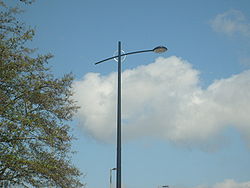
Portsdown and Horndean Light Railway
Encyclopedia

Cosham
Cosham is a northern suburb of Portsmouth lying within the city boundary but off Portsea Island. It is mentioned in the Domesday Book of 1086 along with Drayton and Wymering and Bocheland , Frodington and Copenore on the island.The name is of Saxon origin and means "Cossa's homestead"...
to Horndean
Horndean
Horndean is a village and civil parish in the East Hampshire district of Hampshire, England. It is 8 miles north of Portsmouth.The nearest railway station is 2.2 miles southeast of the village at Rowlands Castle....
in Hampshire, England.
Authorised in 1899 by an Order of the 1896 Light Railway Commission under the Light Railway Act, it opened on 3 March 1903 and started from a junction with the Portsmouth Corporation Transport
Portsmouth Corporation Transport
Portsmouth Corporation Transport was a tram, trolleybus and bus operator formed in 1898 and owned by Portsmouth Corporation. Tram services ended in 1936, while bus operations continued until the company was privatised in 1988.-History:...
street tramway system on the Portsmouth Road, south of Cosham Station
Cosham railway station
Cosham railway station serves the former village of Cosham, today a northern suburb of the city of Portsmouth in southern England.Opened in 1847 by the London and South Western Railway , it is located on the West Coastway Line which runs between Brighton and Southampton...
. The route ran alongside the London Road (now A3) throughout and traces can still be seen as extra-wide pavements in several locations, and the abutments of the old bridge over the Southwick Road in Cosham
Cosham
Cosham is a northern suburb of Portsmouth lying within the city boundary but off Portsea Island. It is mentioned in the Domesday Book of 1086 along with Drayton and Wymering and Bocheland , Frodington and Copenore on the island.The name is of Saxon origin and means "Cossa's homestead"...
. The system transformed the growth of the Waterlooville
Waterlooville
Waterlooville is a town in Hampshire, England approximately 8 miles north of Portsmouth.The town has a population itself of about 10,000 and is surrounded by Purbrook, Blendworth, Cowplain, Lovedean, Clanfield, Catherington, Crookhorn, Denmead, Hambledon, Horndean and Widley. It forms part of...
, Cowplain
Cowplain
Cowplain is a village on the northern outskirts of Waterlooville. With a population of 8775, it takes up 7.3% of Havant borough's population. The origins of the settlement grew along the old London to Portsmouth road...
and Horndean
Horndean
Horndean is a village and civil parish in the East Hampshire district of Hampshire, England. It is 8 miles north of Portsmouth.The nearest railway station is 2.2 miles southeast of the village at Rowlands Castle....
areas. Guidebooks were produced advertising the benefits of healthy country air and fresh farm food The last tram ran on 9 January 1935, by which time it had been superseded by motor buses, and became the Southdown Bus Company Route 42. In 2006 new lighting was installed along the route as part of Havant Borough Council's bus corridor improvement scheme.

